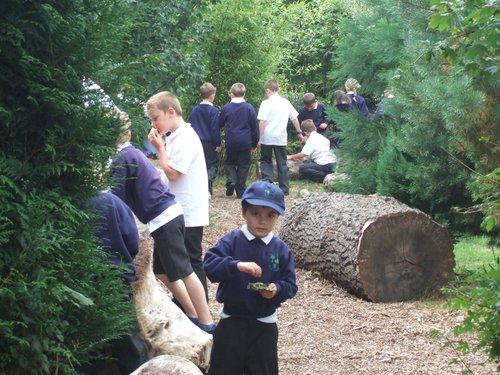Back to nature
We all need to connect with nature, but the modern world can make this hard, particularly for children. Jez Fredenburgh talks to Alice Robin and Guy Redmond of Leaves of Green, who are using the landscape to reconnect communitiesHow has children’s relationship with nature changed?
Guy: As the world has got bigger and communities have expanded, we’ve lost local connections, and that childhood of unsupervised loitering and roaming. Research shows that positive lifelong connections to nature are formed when children have unlimited access to one place over a long period of time.
Alice: Nature is our world. If children are connected to the natural world while growing up, they will be able to make responsible decisions about the environment as adults.

How does Leaves of Green connect people and nature?
Alice: People need beautiful places on their doorsteps, not a car-drive away. Many children do not have gardens, so school grounds and community spaces are essential for providing that. We design and build outdoor spaces where people can access and connect with nature every day.
How did it all start?
Guy: I studied art and architecture, and placemaking – enhancing the unique cultural, aesthetic and ecological qualities of places. In the 1990s I began advising schools on which trees to plant in their grounds. I’d come from a private education background set in a backdrop of ancient landscapes and mature gardens, and was shocked to find a whole education sector with just tarmac and grass. The best setting for academic learning is a backdrop of diverse deciduous and coniferous trees, yet school grounds are the most undeveloped part of the British landscape, when they should be the most wondrous.
What are your designs like?
Guy: We use a lot of regenerative agriculture techniques and strategies. We start with very low maintenance schemes, creating a backdrop of shelterbelts and treescapes, and afterwards we begin to incorporate other elements. Eventually, the culture changes and natural gardeners emerge. The best system for food production is the forest garden – a multilayered 21st century orchard - on a large scale. This is known as agroforestry. Essentially, it’s mixing canopy trees with currants and other bushes, herbaceous, annuals, roots, edible leaves and climbers in a balanced system. Most schools have a field that is often only accessible for three months of the year. Our designs add all-year pathways punctuated with outdoor learning environments, natural play space, woodland, coppice, art, etc. Children will spontaneously play and learn where there is a natural sense of place.
Is your aim social change, as well as ecological?
Guy: It’s about people coming together and participating in a shared endeavour. The attractive landscape created is often superseded by benefits hidden at the outset – better behaviour, character development, risk-taking, working together.
Alice: We recently did a survey on school grounds development, and the main benefits that headteachers listed were an improvement in behaviour and learning ability. Schools can actually use the landscape as an incentive to change behaviour, too. For example, we worked with one that zoned its grounds – there was an area of tunnels and mounds where the children couldn’t be seen, so if children misbehaved they were relegated to zone one, which was the playground. It had a big impact on behaviour.
Can children, locals and farmers get involved?
Alice: Yes, they do. Farmers often have the equipment or know-how, and among the parents and wider community, there are usually all kinds of skills. Mountains can be moved in a day if you organise people well. We’ve worked with many secondary schools, where young people have played an important part in design and construction. It is vital to nurture the students’ skills.
Guy: The most positive projects are the ones that are inclusive and involve children and young people. We all want our immediate environment to look good, and children feel strongly about this too. The schools that make these changes involving their communities end up with an inner glow where everyone feels part of something.

You’re writing a book for schools – what is it about?
Alice: It’s impossible for us to get around all 32,000 UK schools, so we’re working on a 500-page manual to guide schools through the design, philosophy and ‘how to’ of developing their grounds. We want to empower schools and create a generation of children who are more positively attuned to nature and environmental responsibilities. About a fifth has been written, and we’re now looking for funding to finish and publish it. If anyone is interested in helping, please email alice@leavesofgreen.co.uk.
What's the dream?
Guy: A worldwide network archipelago of ‘school gardens of Eden’! If communities got together, we could have paradise on Earth.
Alice, you’re part of the new CLA Women’s Network – what do you envisage it will do?
Alice: It’s early days. We’re looking to increase the profile and voice of women CLA members, to encourage networking, mentoring and professional development among us through a mix of face-to-face events and online contact. Groups will be regional and have local priorities, while connecting nationally.
What can happen when women come together?
Alice: It’s important for inspiration and nourishment, to share our insights and experiences, hear new ways of tackling challenges, and support each other. It could start collaborations between individuals and businesses too. Women sometimes just need more confidence. They often have a good business mindset, and can be inclusive, caring, intuitive, creative problem-solvers. But the feminine perspective has often been missing from decision-making. It’s time for feminine energy to create a balance alongside masculine energy.
How can rural businesses tackle big issues?
Alice: When people talk to each other, they begin to understand what the needs of their communities might be, and it starts to open up possibilities. People are the key – they have so many good ideas, it’s about harnessing their energy.